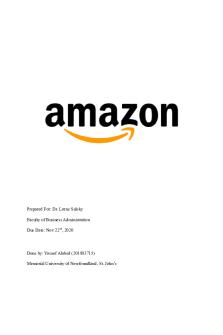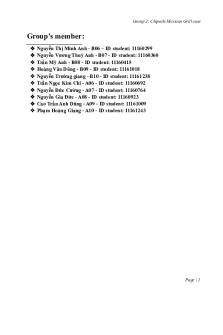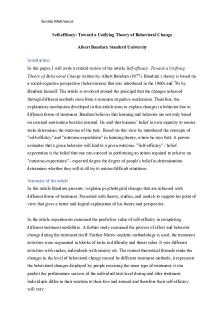FIN 242 Individual Assignment PDF

| Title | FIN 242 Individual Assignment |
|---|---|
| Author | Fahmi Arsyad |
| Course | Fundamentals of Finance |
| Institution | Universiti Teknologi MARA |
| Pages | 9 |
| File Size | 370.2 KB |
| File Type | |
| Total Downloads | 107 |
| Total Views | 253 |
Summary
Download FIN 242 Individual Assignment PDF
Description
FACULTY BUSINESS AND MANAGEMENT
FUNDAMENTALS OF FINANCE (FIN 242)
ROLE PLAY ASSIGNMENT INDIVIDUAL REPORT
A COMPANY’S FINANCIAL CHALLENGE NESTLE MALAYSIA BERHAD COMPANY
ROLE-PLAY/ACTORS: LOCAL BANK FROM MAYBANK
CLASS: BA1193A
PREPARED FOR: SIR MUSTAFA KAMAL BIN MAT
PREPARED BY: FAHMI ARSYAD BIN KHAIRUL AZRI
(2019428902)
TABLE OF CONTENT TOPIC
PAGE
INTRODUCTION
1
FINANCIAL ANALYSIS LEVERAGE OR DEBT MANAGEMENT RATIOS
2-8
CONCLUSION
9
INTRODUCTION
My name is Fahmi Arsyad bin Khairul Azri. In this role play video, I played a role as a local bank which is Maybank. As a local bank, I am responsible for making decisions to provide financial backing but as a creditor in term Nestle Company must have a good income or good cash flow to make sure they pay the debt back. This is because banks gain profit from companies by charging interest to their loan. Since 1912, Nestlé has been cultivating Malaysians with its premium labels and products, while maintaining its excellence and integrity in Halal. This is in conjunction with their objective of unlocking the ability of food to improve the quality of life for all, today and for generations to come. Following Malaysia's independence in 1957, there was a need for expanded job openings and more choices. Following this, the Culinary Products Division started manufacturing exciting culinary solutions under the wellloved MAGGI name in the mid-1960s. This led to the establishment of their first production facility in Malaysia. Today, Nestlé Malaysia operates six factories and employs more than 4,600 workers across the country, manufacturing over 500 Halal-certified products. For decades, many of their main brands have been part of Malaysian households, like Malaysian classics such as Milo, Maggi, Nescafé and KitKat. Having been present in the nation and in the hearts of Malaysians for over a century, they are committed to providing the finest in consistency, diet and taste. At Nestlé, they continually challenge and expand the limits of what is possible with food, beverages and nutritious wellness options to increase the quality of life and foster a healthy future. They target their energies and money where unlocking the potential of food will make the biggest difference to people's lives, conserve and improve the ecosystem, and create meaningful value for both their shareholders and stakeholders. After that, I am the person that company refers to make loans from our bank because Nestle Company fuels its financing more by getting loans from banks than money from shareholders. From this situation, I am responsible to monitor their performance in debt ratio, debt to equity ratio, times interest earned and equity ratio. Lastly, I’m as a local bank must be strict and meticulous person to the company because Nestle Company is a ‘leveraged company’ which mean they have more debt to our bank, so when bank loan the money to the company, company must pay to us to make sure they company are not bankrupt.
Leverage or Debt Management Ratios The leverage ratios measure the extent to which the firm uses debt to finance its investment, how well the firm can meet its interest payment obligations, and the financial risks related to the financing used. 1. Debt Ratio (DR) It measures the percentage of total funds provided by creditors as compared to funds provides from owner’s capital. Total debt consists of current liabilities and long-term debt. Thus, the net of DR is the percentage of funds provided by owners. Higher ratio normally indicates higher financial risk and vices versa. DEBT RATIO = TOTAL DEBT / TOTAL ASSETS
YEAR
WORKING CALCULATION
RESULT
2018
2192949 / 2847282 X 100%
77.02%
2019
2061614 / 2726538 X 100%
75.61%
A measure of financial leverage is the debt ratio. This measured is closely related to debt-toequity ratio. For Nestle company in 2018 is 77.02% (100%-22.98%) while in 2019 is 75.61% (100%-24.39%). This suggests that the Nestle Company uses more debt to fuel its financing. Differentiate amount between 2018-2019 is a small sum which is 1.41%. Noted that the debt ratio in 2018 has better percentage than in 2019. But, Nestle Company still categorized as leverage company in 2019 because a business that has a debt ratio of over 50 percent is known as a "leveraged" business. percentage of debt ratio is higher than equity ratio (75.61% > 24.39%). The higher ratio normally indicates higher financial risk.
2. Debt to Equity Ratio (DER) It is a measure the relative funds provided by creditors as compared to owners or net worth in the firm’s capital structure. Equity is defined as total assets minus total debt. A ratio of more than one, indicates that creditors provided more funds compared to owners. On the other hand, a less than one ratio indicates more funds provided by owners. DEBT TO EQUITY RATIO = LONG-TERM DEBT / EQUITY
YEAR
WORKING CALCULATION
RESULT
2018
2192949 / 654333
3.35 times
2019
2061614 / 664924
3.10 times
Debt to Equity Ratio also known as the external-internal equity ratio since the debt-to-equity ratio. Debt to equity ratio of Nestle Company in 2018 is RM3.35 for each ringgit (3.35: 1) and in 2019 is RM3.10 for each ringgit (3.10: 1). Creditors view a higher debt to equity ratio as risky because it shows that the investors haven’t funded the operations as much as creditors have which mean investors don’t have as much advantage in the game as the creditors do. This mean that investors don’t want to fund the business operations because the company is not performing well. Lack of performance could also be the reason why the company is seeking out extra debt financing.
3. Times Interest Earned (TIE) This ratio measures the of the firm’s ability to meet interest payments and the extent to which earnings can decline without resulting in financial embarrassment due to its inability to meet annual interest costs. Higher ratio indicates higher capability and lower risks of default. Note that this measure does not consider either lease payments or the repayment of principal on loans. TIMES INTEREST EARNED (TIE) = EARNINGS BEFORE INTEREST AND TAXES / INTEREST
YEAR
WORKING CALCULATION
RESULT
2018
897777 / 43123
20.82 times
2019
891033 / 40663
21.91 times
Times interest ratio also to see a long-term solvency ratio that measures the ability of a company to pay its interest charges as they become due. Times interest earned ratio for Nestle Company in 2018 is 20.82 times and 2019 is 21.91 times. It means that the interest expenses of the company in 2018 cover 20.82 times and 2019 is 21.91 times covered by its net operating income (income before interest and tax). Noted that 2019 is the better than 2018 because the company has high expectation to pay the debt for a long term.
4. Equity Ratio (ER) This ratio measures the portion of total assets provided by equity. For example, owners' contributions and the company's accumulated profits. Potential investors and creditors prefer to see a high equity ratio, since it implies that a company is conservatively managed and always pays its bills on time.
EQUITY RATIO = TOTAL EQUITY / TOTAL ASSET
YEAR
WORKING CALCULATION
RESULT
2018
654333 / 2847282 x 100%
22.98%
2019
664924 / 2726538 x 100%
24.39%
The equity ratio is a leverage ratio that calculates the share of the equity-funded assets. For Nestle Company, in 2018 is 22.98% (100%-77.02%) while in 2019 is 24.39% (100%-75.61%). From this result, 2018 has better equity or owner’s capital than 2019. It is defined as a leveraged company when the equity ratio of a company is less than 50 percent. Leveraged businesses pay more interest on loans. The example is debt ratio for Nestle Company in 2019 is 75.61% while for equity ratio is 24.39%.
CONCLUSION
In conclusion, as a local bank, I am very serious and concerned about Nestle Company performance because in order to pay the debt, they must have a good performance in cash flow. From the Nestle Company performance in leverage or debt management ratios, I seem satisfied because the debt ratio 2019, is 75.61% and still maintains it. But, Nestle Company must be aware because higher ratios normally indicate higher financial risk. I see that wherever Nestle Company has a problem in paying the debt in the short term, the Nestle company has improved in paying the debt in the long term (Times Interest Earned) which has increased from 2018 to 20.82 times and 2019 is 21.91 times. It means that the interest expenses of the company in 2018 cover 20.82 times and 2019 is 21.91 times covered by its net operating income (income before interest and tax). It's good for our bank which is Maybank because we can gain profit for a long term period. But Nestle Company must improve their interest to pay the debt in the short term. At debt to equity ratio for Nestle Company, creditors view a higher debt to equity ratio as risky because it shows that the investors haven’t funded the operations as much as creditors have which means investors don’t have as much advantage in the game as the creditors do. So, Nestle Company has to be cautious here and at the same time make a high profit to make sure they can pay the debt to the bank....
Similar Free PDFs

FIN 242 Individual Assignment
- 9 Pages

FIN 242 Individual Report (MBA1114E)
- 17 Pages

FIN 533 Individual Assignment
- 21 Pages

Fin 242 group assignment air asia
- 20 Pages

FIN assignment
- 10 Pages

Individual Assignment
- 26 Pages

Individual Assignment
- 20 Pages

Individual assignment
- 5 Pages

Individual assignment
- 3 Pages

MGT 162 INDIVIDUAL ASSIGNMENT
- 24 Pages

finance - individual assignment
- 7 Pages
Popular Institutions
- Tinajero National High School - Annex
- Politeknik Caltex Riau
- Yokohama City University
- SGT University
- University of Al-Qadisiyah
- Divine Word College of Vigan
- Techniek College Rotterdam
- Universidade de Santiago
- Universiti Teknologi MARA Cawangan Johor Kampus Pasir Gudang
- Poltekkes Kemenkes Yogyakarta
- Baguio City National High School
- Colegio san marcos
- preparatoria uno
- Centro de Bachillerato Tecnológico Industrial y de Servicios No. 107
- Dalian Maritime University
- Quang Trung Secondary School
- Colegio Tecnológico en Informática
- Corporación Regional de Educación Superior
- Grupo CEDVA
- Dar Al Uloom University
- Centro de Estudios Preuniversitarios de la Universidad Nacional de Ingeniería
- 上智大学
- Aakash International School, Nuna Majara
- San Felipe Neri Catholic School
- Kang Chiao International School - New Taipei City
- Misamis Occidental National High School
- Institución Educativa Escuela Normal Juan Ladrilleros
- Kolehiyo ng Pantukan
- Batanes State College
- Instituto Continental
- Sekolah Menengah Kejuruan Kesehatan Kaltara (Tarakan)
- Colegio de La Inmaculada Concepcion - Cebu




